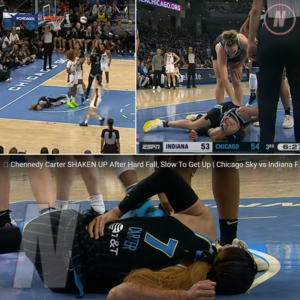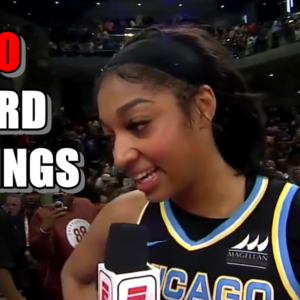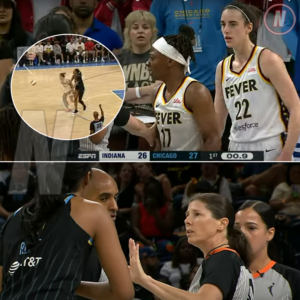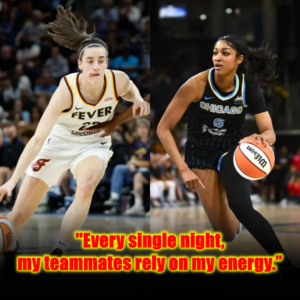It’s a little after 11 a.m. on an unnervingly cold December day, and Isaac Prewitt exhales.
Hands on hips, cheeks puffed out, the whole deal. His morning had been relatively easy for a while: Play dummy defense against pick-and-rolls; needle his friend about an incoming shipment of Gatorade Fit drinks; run some zone offense.
A graduate student, whiling away winter break in a gym, doing a job that’s never work.

For the last few minutes, though, his job stinks.
Because his job is Caitlin Clark.
He wears a blue scout-team pinnie and pursues his pal with the Gatorade hook-up during an Iowa women’s basketball practice, slaloming around bodies trying to bump him off course, doing what he can to prevent a generationally gifted scorer from, well, scoring.
At one point, Prewitt challenges a Clark 3-pointer so aggressively that his fingers interlock with Clark’s on her follow-through. She makes it anyway. Prewitt laughs.
Male practice players have been around women’s basketball for at least a half-century, mimicking the opposition’s schemes and personnel. They’re generally in the gym to help, not to win, often getting nothing except cardio for their effort.
But unfair fights are one thing.
How about a 6-foot-4 Stanford forward with an impossible wingspan and deceptive speed?
A teenage prodigy at USC with a bottomless bag of answers? The Iowa guard who might score more points than any player in college ever has?
What, in fact, do you do about all that?
For starters, you keep coming back for more. After that deep breath, Prewitt lines up across from Clark. “Talk to me, talk to me,” he calls out, wary of a screen. It comes. Help defense does not. He lunges at Clark as she hoists another 3-pointer. She cashes it. And Isaac Prewitt throws his hands in the air.
Iowa coach Lisa Bluder has seen this before, and seen enough. “Let’s let blue get a drink,” she says.

In 1974, eight years before the NCAA even began to sponsor women’s basketball, Pat Summitt took over as Tennessee’s head coach. She signed up men to compete as practice players immediately.
“The most natural thing in the world for me,” Summitt told Sports Illustrated a quarter-century later. Thing is, the Hall of Fame coach didn’t claim the idea as hers.
No one seems to know who came up with it, only that it’s been a ubiquitous and useful resource for women’s hoops as far as they can remember.
“They’re essential to our success,” says Virginia Tech coach Kenny Brooks, a few months removed from a Final Four run in 2023. “We don’t have the budget that when we get rings, they do. But I wish we could. I really do. They’re that important.”
Enough that, these days, they’re often recruits of a different sort. Scouted not in grassroots showcases but in intramural runs at the campus rec center. Wooed not with letters and photo shoots but via want ads on social media.

At South Carolina, Denton Rohde went from standard incoming student to guarding future No. 1 pick Aliyah Boston and now 6-7 center Kamilla Cardoso, all thanks to a Facebook post his mom saw.
(“We like tall freshmen,” Gamecocks coach Dawn Staley told the 6-6 Rohde at his first workout.)
Hasani Spann had Division III offers, opted for an academic full ride to Stanford, got directed to the women’s hoops practice squad by a men’s assistant coach and now chases Hannah Jump around the 3-point arc or tangles with two-time All-American Cameron Brink on the block.
Jared Wilson went from pickup games at Southern Cal’s Lyon Recreational Center to trying out for the club team to guarding JuJu Watkins, the nation’s top freshman, whose precocious talent has drawn the likes of Kevin Hart and LeBron James to home games. “I had no idea,” Wilson says, “it would totally consume me.”
“We always say time doesn’t exist when we’re in there,” says Rohde, who’s now a senior. “School doesn’t matter. Whatever’s stressing you out – drama in your personal life, whether you’re down that month – it just doesn’t matter.
You’re focused, you’re practicing, you have the player you’re scouting for, you have plays you have to know. You’re trying to compete in every single drill and you’re playing a team that is quite literally the best team in the country. There’s just no other feeling like it.”
A fair enough summary of what they get out of it, besides getting cooked.
Most played at least through high school. (Prewitt, in fact, logged one season at NAIA Dordt University before transferring to Iowa.) They are good enough to be told to hold back, occasionally; after Rohde once scored for the scout team on a Eurostep reverse, South Carolina’s coaches reminded him: Your player is a post. You cannot do that.
Some, like a trio at Southern Cal, use it as an entry point to careers in the sport. One of Brooks’ former practice players, Aaron Smith, is now an NBA referee. But regardless of their trajectory relative to the game, reckoning with the end of the competitive line can be a direct hit to the feels.
These tours of duty delay the inevitable. “It was great to find a way to still be on the court, pumping my blood,” Spann says. “The girls? Oh, they hate you.
They hate if they lose to you. Our primary job is to get them better, but getting them better is not giving them leeway. It’s not letting them do what they want.”
An itch, scratched daily. “It’s hard for us to check our ego at the door,” says Will McIntire, who shares Caitlin Clark duty at Iowa while aspiring to a coaching career in women’s hoops. “That’s the best part about it.
If we’re whupping the girls one day, we’re getting buckets on them, and some days they’re getting buckets on us and we’re chatting back and forth – (the coaches) eat it up. They love to have that competitive energy.”
The utility for the programs is plain. Everyone gets quality reps against theoretically bigger or stronger or quicker or more explosive bodies without getting hurt. Down-the-roster players don’t waste time learning plays only for scout-team purposes. “That isn’t helping them be better Iowa players,” as Bluder puts it.

And over a long season, it mitigates teammate-on-teammate wear-and-tear. “Elizabeth Kitley doesn’t need to practice two to three hours a day, getting every rep,” Brooks says of his All-America center at Virginia Tech.
Instead, Brooks can work through a full seven- or eight-player rotation, both to build chemistry and ease up on legs.
The guys take the beating. The women take breathers.
“It’s a huge help,” says Stanford’s Brink, who otherwise would be colliding with 6-3 teammate Kiki Iriafen, the Cardinal’s second-leading scorer.
“Kiki and I, things can definitely get heated when we’re going against each other. For me to get a break guarding her, and for her to practice guarding guards, it’s great. They help us expand our games and make us better, for sure.”
Often, of course, at their own expense.
“In short, it’s not going too well for me,” says Gavin McDonnell, a Stanford practice player who, pushing 6-5, spends most of the season on a very perilous Brink. “Just kind of a massive nightmare.”
The job is about what you’d expect. In certain locales – the 2023-24 season features nine players who earned All-America nods last year – it’s perhaps as onerous as it’s ever been.
Rohde’s initiation at South Carolina came by way of three-time All-American Aliyah Boston – “She was patient, smart and had a counter to anything you could throw at her,” he says – but the days, and the opposition, remain long.
The 6-7 Cardoso has filled the space vacated by Boston, shooting 60.3 percent and averaging 21.6 points and 16.3 boards per 40 minutes.
Sagging off and giving Cardoso a midrange look is no longer an option for Rohde.
Nor is betting that she won’t put the ball on the deck. All while she’s enhanced her capacity to baffle Rohde at the rim, particularly with one move in which Cardoso essentially goes under the hoop and fades away, erasing all angles for a possible block.
“I’ve played against people who are in the NBA, like, right now,” Rohde says.
“I played against many 6-8, 6-10 Division I players and I’ve never had as many moments with a player where there’s absolutely nothing I could have done to block that.”
His counterparts on the other side of the country can sympathize. Brink currently produces at a preposterous rate of 31.5 points, 20.4 rebounds and 5.7 blocks per 40 minutes, all of which are career-bests.
“You pick your poison with her,” McDonnell says. “It’s so hard to guard her closely and not foul. She’s super-quick, too. … She’ll slip right by you.”
McDonnell has the height and reach and frame to challenge Brink with physicality and contest shots – and it’s futile. “She usually just scores,” he says with a laugh.
These are the known quantities, though. No one’s opening a mystery box daily. What’s coming is clear.
It’s a little different when you see the comet right before it passes the sun and starts to glow.
JuJu Watkins arrived at Southern Cal as the nation’s No. 1 recruit last summer, as conspicuous as prospects get. Everyone wanted to see the video highlights cut-and-pasted into real life.
On the first day of workouts, Watkins crossed over a practice player so badly that Reagan Griffin Jr., another squad member, thought to himself: Is it really like that?
When the women and men scrimmaged in the preseason, and Watkins scored six points on three possessions against a 6-4 former California high school state champion, the answer was clear.
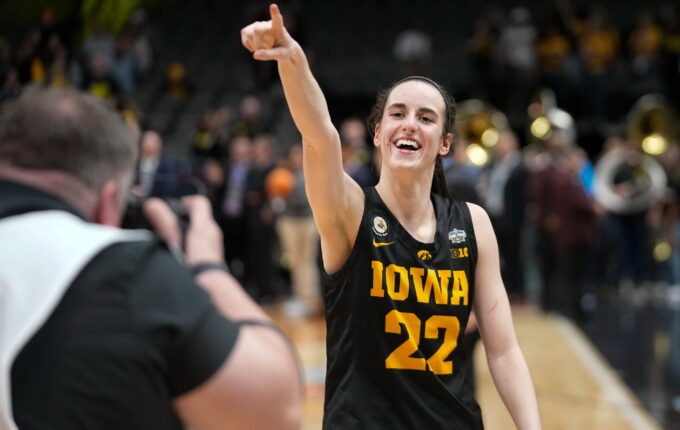
“Homey is looking at me from the court like, what’s going on?” Griffin Jr. remembers. “At that point, everyone knew who the best player in the gym is.”
Still, she’s 18. She may be a budding genius with endless counters – “You can’t ever really stop her because her bag is so deep,” says Wilson, who is her primary practice foil – but she’s nevertheless budding.
She may be physical – on the first day Yusuf Ali guarded her, the first-year practice player remembers Watkins nearly knocking him over when she engaged her off-hand – but she’s also growing.
Early on, Ali could fake a stunt when Watkins drove, making her think a kick-out was available, and then jump the passing lane for a steal.
It’s why Watkins takes a moment after a recent practice to find the right word to describe her foils.
Annoying, she says, isn’t quite it. Very active is what she settles on.
“It definitely forces your IQ to really show up in moments where the defense does have somewhat of an advantage, just making sure you’re making the right play every time,” Watkins says.
“To get that in practice every day just makes the game that much easier.” Watkins indeed learned with each noon-run-at-the-YMCA trick. And then the fakes stopped working.
“She’s gotten harder and harder to guard each week,” Ali says. “Each time I’ll try something new, she’ll have a counter for it the next practice.”
This is what Southern Cal’s practice squad gets in addition to its troubles: fascination. The idea that Watkins is all of this, and yet not what she’ll be. The satisfaction in helping her figure it all out.
“On a day-to-day basis,” Griffin Jr. says, “you feel like you’re watching greatness.”
About 1,800 miles east, they can relate.
